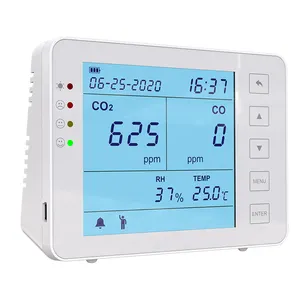

LCD Display Air Quality Monitor CO2 Meter Multi-functional Gas Detector For CO2 CO Temp RH




Carbon dioxide (CO2) detectors are critical devices designed to measure and monitor the levels of CO2 in various environments. These detectors are essential for ensuring the safety and well-being of individuals in spaces where CO2 accumulation can pose a risk, such as industrial sites, commercial properties, and residential areas.
CO2 detectors come in various forms, including wall-mounted units, handheld devices, and even smart, integrated systems. Each type is equipped with sensors that respond to varying levels of CO2, providing real-time readings and alerts. Features may include data logging, wireless connectivity, and multi-gas detection capabilities, catering to diverse monitoring needs.
Monitoring CO2 levels is crucial in industries like manufacturing, brewing, and agriculture, where CO2 is a by-product. In residential settings, CO2 monitors ensure that ventilation systems are effective, preventing the buildup of this odorless and colorless gas to dangerous levels.
The construction of a CO2 sensor typically involves robust materials that can withstand various environmental conditions, ensuring durability and reliability. The design of these sensors is often compact and user-friendly, allowing for easy installation and maintenance.
Utilizing a carbon dioxide detector is advantageous for maintaining air quality and safety. These devices can help prevent health risks associated with high levels of CO2 and are an integral part of environmental safety protocols in many industries.
Choosing the appropriate CO2 detection system depends on the specific requirements of the environment it will be used in. Factors to consider include detection range, accuracy, response time, and the presence of additional gases that need to be monitored.